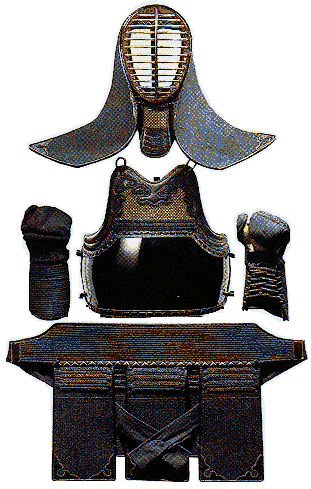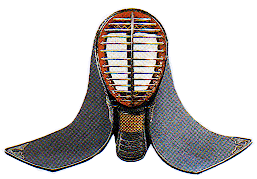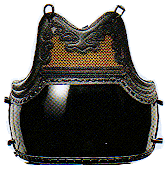
KENDO TERMINOLOGY

IAI : The drawing and sheathing of the katana.
IAIDO : The way of drawing the sword.
BATTOJUTSU : Another name for iai.
KENDO : The way of the sword.
KORYU : Old school or lineage.
TYPES OF ETIQUETTE :
REIGI : Etiquette.
REIHO : Etiquette, method of bowing.
REISHIKI : Same as above.
SAHO : Method of etiquette.
HAJIME NO SAHO : Beginning etiquette.
OWARI NO SAHO : Finishing etiquette.
DATTO : Taking sword from belt
KEITO : Same as teito shisei.
TAITO : Putting sword into belt
TEITO : Holding the sword loose by the left side.
Also used when sword is in belt and both hands loose at sides.
TEITO SHISEI : Holding the sword by the left side,
as if in the obi. Thumb on tsuba.
BOWING :
REI : Bow.
JOSEKI NI REI : Bow to the high section of the dojo.
KAMIZA NI REI : Bow to kamiza ( gods )
SHINZEN NI REI : Bow to shrine.
SENSEI (GATA) NI REI : Bow to teacher(s)
TO REI : Bow to sword.
OTAGAI NI REI : Bow to each other.
TACHI REI : Standing bow.
RITSU REI : Same as tachi rei.
ZA REI : Kneeling bow.
RANKS & TITLES :
SENSEI : Instructor.
SHIHAN : A senior teacher, properly used within the
school only, when outside, use sensei.
SEMPAI : Senior student.
KO HAI : Junior student.
KYU : Student grade, from 5 to 7 up to 1, the highest.
DAN : More advanced grades, from 1 to 10.
YUDANSHA : Members with dan grades.
MUDANSHA : Members with kyu grades.
HANSHI : Highest title, must be 55 or older and 8
dan.
KYOSHI : Middle title, must be 7th dan.
RENSHI : Title bestowed in addition to Dan ranks.
SOKE : Head of style ( actually head of family, unifier
of gods and lineage )
KAICHO : Owner of school ( organization )
KANCHO : Owner of school ( building, hall )
DOJO ARRANGEMENT :
DOJO : Practice hall.
KAMIZA : Altar.
SHOMEN : Front of room.
JOSEKI ( JO ) : High side, also called shinzen.
GE : Side of dojo opposite shinzen.
SHIMOSEKI, SHIMOZA : Opposite sensei, where students
sit.
In the dojo, students line up on one side of the room,
instructors on the other.
Shinzen is one of the two remaining sides, usually
depending on where the door to the room is.
If the door is in a corner, usually that corner is
where the lowest ranked students would sit.
Preferably, shinzen is to the east.
Shomen
Sensei
Jo
Shinzen Ge
Sempai
--> Decreasing in rank &nbbsp; Door
Shimoza
PHILOSOPHICAL CONCEPTS :
AIUCHI : Mutual strike, strikes at the same time.
BUDO : Way of war.
BUSHIDO : Way of warrior.
DAI KYO SOKU KEI : Big, strong, fast, smooth.
DEHANA WAZA : Strike at the outset, as opponent moves,
like sen no waza.
DO : Activity, motion.
FUSHIN : Frozen or stopped mind.
FUDOSHIN : Immovable mind, calm spirit.
FUKAKU : Personal character.
GOKAI : Grandeur, large feeling, full motions.
GO NO SEN NO WAZA ( GO NO SEN ) : Strike at a suki,
a mind stopping. Strike before the opponent forms the intention to strike.
HEIJISHIN : Ordinary mind.
JO HA KYU : Slow, faster, fastest.
KAKE GOE : Yelling to get extra energy.
KENSEN : Pressure from the sword, esp. the tip.
KI : Spirit, energy, inner strength.
KI KEN TAI ICHI : Spirit, sword, body, one.
KIAI : Shout, yell.
KIME : Sharpness of movement, positive end of cut
or thrust.
KIMOCHI : Feeling, sensation.
KIRYOKU : Willpower.
KOKORO/SHIN : Mind.
KOKYU : Breath, breath power.
MA : Distance, space, interval ( in time ).
MAWAI ( MAAI ) : Mutual distance.
MUSHIN, MUSO : No mind, no rationalization.
MUGA : No ego.
MUNEN : No thought.
OI WAZA : Chasing or following strikes, attack as
opponent retreats.
RIAI : Unification of action and theory.
SAYA NO UCHI NO KACHI : Saya = scabbard, uchi = inside,
kachi = victory. The sword in the saya, winning without drawing.
SEN : Initiative, to forestall.
SEN NO WAZA ( SEN ) : Strike faster than opponent,
before attack delivered.
SEN SEN NO WAZA ( SEN NO SEN ) : Strike as opponent
commits to an attack but before he moves.
SEI : Motionless, inactive.
SHU HA RI : Keep, break, leave. Memorize technique,
question and understand, forget technique.
SUKI : Opening.
SUTEMI : Sacrifice technique, accept a blow to deliver
one.
THE BOGU :
TENUGUI : Small hand cloth to wipe face. Also worn
under the helmet in kendo.
KEIKO GI : Practice uniform.
KENDO GI : Practice uniform for kendo.
EMBU GI : Demonstration top / uniform.
GI : Refers to top only.
KAMISHIMO : Over vest / jacket.
KESA : Lapel / part of monk's costume hanging from
left shoulder.
MON : Family crests on uniform.
MONTSUKI : Wide sleaved top with mon on chest, sleeve
and back.
SODE : Sleeve, on practice top.
TANOMO : Large sleeves on formal tops.
UWA GI : Practice top.
ZEKKEN : Chest patch embroidered with own name and
dojo name.
OBI : Belt.
HAKAMA : Split skirt, wide legged pants.
HIMO : Straps / cords.
HERA : Peg in back of hakama.
MATADACHI : Split in side of hakama.
KOSHI ITA : Back plate on hakama.
TABI : Japanese sock-slippers used in dojo.
ZORI : Japanese sandals for use outside dojo.

BOGU : The Kendo Armour. |

MEN : Helmet / Face-guard.
KOTE : Gloves / Gauntlets. |

DO : Breastplate.
TARE : Protective Skirt. |
NAKAYUI : The middle knot that holds the shinai staves together TSUKAGAWA - the leather handle TSUBA : Disc guard TSUBADOME : The rubber that keep the guard from sliding down. |
 |
HOLDING THE SHINAI :
TE NO UCHI : Grip on sword with fingers pulling into
palm.
SHIBORI : Wringing. Twisting the hands inward over
the handle on the cut.
HASUJI : Angle of movement of the edge.
KIRI TE : Grip that allows cutting action with blade.
SEME TE : Pushing hand. Pressing forward with the
blade.
MAMORI TE : As for seme te. Covering or protecting
hand.
SHINI TE : Hand position that does not allow a cut.
TOME TE : Stopping hand, one that is defensive.
NOBI TE : As for shini te.
KATA TE : One handed.
MORO TE : Two hands on tsuka.
SOE TE : One hand on tsuka, one on blade.
POSTURES :
HANMI : Half forward stance.
HITOEMI : Equal stance, feet parallel forward.
IAI GOSHI : Hips lowered, stable position.
IAI HIZA, TATE HIZA : Kneeling on one calf.
KAMAE : Posture, stance.
KIZA : Kneeling, but up on the toes.
SEIZA : Kneeling on both calves.
SONKYO : Squatting ( crouching ) position in Kendo
practice.
TACHI : Standing.
JODAN : Upper level, sword above head. Usually hidari
jodan, left foot forward.
CHUDAN : Middle kamae, sword in middle, seigan is
a chudan gamae.
GEDAN : Lower level, sword pointed down.
HASSO GAMAE : Figure 8 stance, sword by side of head.
Usually hasso hidari, sword on right, left foot forward.
KARUMA : Like waki gamae, blade horizontal.
KASUMI Arms crossed over to hide technique ( mountain
mist ).
KONGO : Blade vertical in front of face.
SEIGAN : Natural step, fundamental kamae.
WAKI GAMAE : Sword pointed down and back, for a sutemi
( sacrifice ) waza.
Usually sword on right side ( migi waki gamae ), left foot forward.
Other purpose - hiding length of sword, especially in case of a broken
one.
FOOTWORK :
AYUMI ASHI : Normal walking motion, back foot slides
up to become front foot.
TSUGI ASHI : Half step, rear foot up to front then
front forward again.
FUMI KOMI : Shift forward, as in a strike, using the
hips.
FUMI KOMI ASHI : Foot motion as shifting forward,
front and back slide together, not two different movements.
OKURI ASHI : Following foot, step forward with front
foot, then rear foot moves same distance forward to regain original distance
apart.
BODY MOVEMENT :
TAI SABAKI : Body motions. TAI = Body. SABAKI = Movement.
HIRAKI ASHI : Rear foot moves forward and turns to
face opponent.
Front foot turns to establish feet again in kamae but with opposite foot
forward.
IRIMI : Entering.
JIKU ASHI : Turning foot, the main axis of rotation.
KAITEN : Turning.
MAWARI : Swinging around.
SEME ASHI : Pushing or pressing foot.
SURI ASHI : Sliding foot.
TENKAN : Moving one foot behind the other to face
180 degrees.
DIRECTIONS :
MAE : Forward.
MIGI : Right.
HIDARI : Left.
USHIRO : Backward.
OMOTE : Front.
URA : Back.
UCHI : Inside.
SOTO : Outside.
JODAN : High.
CHUDAN : Middle.
GEDAN : Low.
ICHI MON JI : A straight line.
TATE ICHI MON JI : A vertical line.
YOKO ICHI MIN JI : A horizontal line.
CHOKKAKU : Right angles.
DO : Degrees, eg. kyu-ju do = 90 degrees.
HEIKO : Parallel.
KAKUDO : Angle.
MASSUGU : Straight ahead.
NANAME : Diagonal.
OTOSHI : Dropping.
SHOMEN : Straight ahead.
UE : Up.
YOKO : Horizontal, to the side.
ASOKO : Over there.
BIKI : To move, as in saya biki or hakama biki.
GYAKU : Reverse, opposite, inverted.
HANTAI : The other way around.
KIKU : Lower.
KOMI : Coming close or drawing near.
SOKO : There, that position.
PARTS OF THE BODY :
NAKAZUMI : Centreline of body.
ATAMA : Head.
MEN : Face.
SHOMEN : Front or top of head.
YOKOMEN : Side of head.
SHAMEN : Side of head, temple.
GANMEN : Point on face between the eyes.
SUNMEN : Same as ganmen.
ME : Eye.
MIMI : Ear.
JINCHU : Centre of upper lip.
KUBI : Neck.
NODO : Throat.
DO : Chest / side of body at ribs.
SUI GETSU : Solar plexus.
MUNE : Chest. Particularily the area over the heart,
in kendo, the embroidered part of the do above the do target.
TE : Hand.
TE KUBI : Wrist.
OMOTE : Open / palm of hand.
KOTE : Wrist / forearm.
HIJI : Elbow.
KATA : Shoulder.
UDE : Arm in general.
URA : Back of hand.
YUBI : Finger / toe.
KOSHI : Hip.
HARA : Abdomen.
TANDEN : Centre of balance, below navel.
ASHI : Foot or leg.
ASHI KUBI : The ankle.
OFFENCE & DEFENCE :
AIUCHI : Strike together.
ATE : Strike.
GYAKU KESA GIRI : Diagonal upward cut.
KATATE UCHI : One handed cut.
KESA GIRI : Diagonal downward cut. A kesa is a sash
worn diagonally across the chest by buddhist priest.
KIRI : Cut.
KIRI AGE : Same as gyaku kesa giri.
KIRI GAESHI : Large diagonal cut, sword finishing
in waki gamae position.
KIRI KUDASHI : Finishing cut.
KIRI OTOSHI : Dropping cut, straight down.
MOROTE UCHI : Two handed cut.
SHOMEN UCHI : Strike on front of head.
SUNE GAKOI : Block to protect the leg ( shin ).
TSUKI : Thrust.
UCHI : Strike.
UKE NAGASHI : Receive and deflect.
YOKOMEN UCHI : Strike on side of head.
YOKO GIRI : Horizontal cut.
NAMES OF ROLES :
KASSO TEKI : Invisible opponent.
MOTODACHI : Defender, teacher side in waza practice.
NAGE : Performer of technique.
SHIDACHI ( SHI TACHI ) : Completing sword. Finishes
partner practice.
TEKI : Opponent.
TORI : Attacker.
UCHIDACHI ( UCHI TACHI ) : Entering sword. The Attacker
in partner practice.
UKE : The Receiver in partner practice.
TYPES OF PRACTICE :
ENBU : Demonstration.
KATA : Structured practice; form or pattern.
JI GEIKO : Free practice.
JOGEBURI ( JOGESUBURI ) : Suburi with the finishing
position with tip about 2" above floor.
KAKARI-GEIKO : Practice where the instructor offers
openings to the student, who must attack the openings immediately.
KEIKO : Practice.
KIRI KAESHI : This is the migi-men, hidari-men practice
with another person blocking.MI TORI KEIKO Watching practice.
NANAMAE MEN : Suburi with the "corners" of the head
as target, 45 degree angle - same technique as in kiri-kaeshi.
OJI WAZA : Receiving techniques.
SAIUMEN : Suburi practising left and right yoko-men
alternately.
SHIAI : Competition.
TAIKAI : Match within a competition.
TAMESHIGIRI : Test cutting.
UCHIKOMIGEIKO : Continuous attack practice.
KENDO WAZA :
Ashi-waza : Foot technique.
Debana-waza : Attack-at-the-start technique.
Gedan-waza : Sword lowered technique.
Harai-waza : Warding-off technique.
Hiki-waza : Stepping-back technique.
Jodan-waza : Sword-over-head technique.
Kaeshi-waza : Reverse-side or rotating warding technique.
Katate-waza : Single-hand technique.
Katsugi-waza : Shouldering-the-sword technique.
Kiri-otoshi-waza : Both cut men, the weaker cut bounces
off and the stronger, more centred cut hits the target.
Maki-waza : Rolling-off technique.
Nidan-waza : Two-step technique.
Nuki-waza : Displacement, dodging or avoidng technique.
Sandan-waza : Three-step technique.
Sayai-waza : Small wrist swing technique.
Shikake-waza : Offensive techniques.
Suriage-waza : Any counter-attack technique which
involves creating the opportunity by sliding your shinai upwards along
the opponent's shinai.
Uchiotoshi-waza : A downward strike used to knock
the sword away or out of the opponent's hands.
IAIDO WAZA :
HENKA WAZA : Small variations in same basic technique.
KAE WAZA : Substitute or totally different techniques.
WAZA : Technique.
KOKYU : Breath control.
CHOSOKU : Breathing.
METSUKE : Gaze.
ENZEN NO METSUKE : Gaze at the far mountains.
BATTO : To unsheath a sword.
NUKI TSUKE/KIRI TSUKE : Simultaneous draw and strike.
TATE HA : Standing edge, draw with edge up.
JO HA KYU : Acceleration, buildup to climax.
SEME : Pressure.
SEMERU : Pressing forward.
SAYA BIKI : Movement of scabbard.
SAYA BANARE : Tip at koiguchi during draw, just before
strike, the flight from the scabbard.
KIME : Focus.
FURI KABURI : Lifting sword from nuki to morote jodan.
KIRI KUDASHI/KIRI TSUKE : The finishing strike.
HIKI TAOSHI : Pulling down. ( Usually the opponent
).
HIKI KIRI : Pulling cut, usually when pulling over
teki.
HANE AGE : Flipping over. ( Flipping up the blade
).
CHIBURI : Shaking off the blood, cleaning the blade.
O-CHIBURI : Large or circular chiburi.
YOKO CHIBURI : Horizontal chiburi, move to the side.
CHINUGUI : Wiping off the blood, as is done in uke
nagashi.
NOTO : Replacing the blade in the saya.
TATE NOTO : Standing noto, blade replaced with edge
facing up.
ZANSHIN : Awareness, watchfulness.